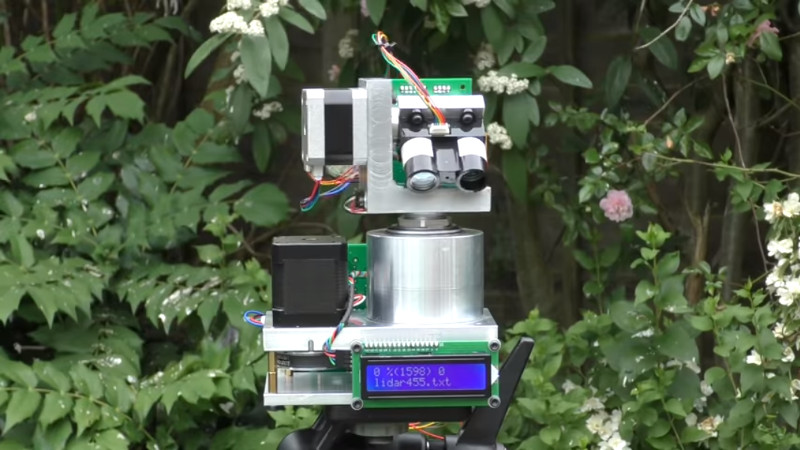LIDAR is a very exciting technology that is only just now starting to become accessible to the DIY market. Think radar, but with lasers. There’s a few different modules starting to pop up for just a few hundred dollars. But what is one to do with a LIDAR module? Well, [David] decided to build a room scanner with his Garmin LIDAR Lite, and it’s a wonderful sight to behold.
The scanner consists of a rotating platform, which is driven by a stepper motor. The platform then contains a second motor which runs a tilt axis, upon which the LIDAR is mounted. By aiming the LIDAR in various directions, and recording the detected range, it’s possible to build a point cloud representation of the surrounding area.
The build uses a couple of STM32 chips to do motor control and interface with the LIDAR, but where this build really shines is the mechanical side of things. [David] goes into serious detail about the machining of the parts that make up the rotating system, and there’s plenty of cool bits and pieces like slip rings to make it all work. There’s even some home casting going on here! Be warned, though: there’s some rather juicy close-ups of lathes in action, so put the kids to bed before watching this one all the way through.
We love to see a well-executed build, and even more so when we get to watch the intricate details of how it came together. If you’re still looking for some more inspiration, we’ve seen other LIDAR room scanners before, too.
















Beautiful maker video, but why not using rotating mirrors, at least on one axis ?
Many commercial units do exactly that, but I think in the case of the Garmin, the offset between the transmit and receive units is too large, which would require an unusually large mirror and might cause the range data to get distorted based on mirror angle.
Most commercial units such as the damaged SICK S300 Mini on my desk have coaxial optics – transmit in the center, surrounded by a receive lens.
And then the hard part in converting that point cloud into something useful.
Laser is the sausage
L.D.A.R ? already made. Irrelevant show off machining check. Unnecessary 3D printing check. Detail on any thing absent check. Total waste of time for all check.
Doesn’t understand hackaday: [X]
Sucks at making checklists: [X]
Burn!
God these comments can be bitter and sad. Why don’t you invent something?
It’s a amazing display of skills, but I’m wondering why he’s machining everything (and pouring aluminum). It seems to be a bit over the top?
Wouldn’t it be much easier and faster to just 3D print everything?
Or would that result in lower precision?
It’s fun to try some new skills, or exercise those that you already have. Almost everything can be jigsawed from plywood, breadboarded, etc, but I enjoyed watching him do all those things. Maybe I would want to try one of them some day.
If you want to make an apple pie from scratch, you must first create the universe.
Nice design. Could easily be broken into a piece for Mechanical Engineers, Electrical Engineers and Software Engineers. I’d love to know more about the Unity interface and the point cloud process. Also, are there any issues with parallax at very short ranges (less than 20x the RX to TX spacing).
The cat was terrific!
Most people who make their own real tools prefer metal. 3d printing is easy and quick- but usually not durable- and suffers from thermal expansion much more than metal parts. Its great for proving concept quickly, but not reliable long term.
I know I will get flack for saying that- but its still true. When I want to make a real tool I make it out of metal, because often it’s quicker to just cut metal than deal with scaffolding and infill and all the other crap you have to do with 3D printing. In the time it takes someone else to print something I can usually have long since machined the object out of metal while they are still laying plastic.
Oh yeah, I don’t think many will argue with you there. If you have the equipment and skill to billet it out of aluminum it’s going to be superior to PLA or whatever in nearly every way.
Sometimes it’s frustrating to see somebody 3d-print an object or tool that would be perhaps a one- or two-step process to subtractively manufacture, like drilling a hole and a quick cut with a hacksaw. But people become accustomed to a flexible solution and sometimes forget there’s other ways to consider. It’s not a terrible problem to have, and I think people who have been used to 3d printing for a long time and haven’t busted out chisels and files are probably unjustly intimidated by working with metal or other fine old crafts. It’s always good to learn by doing the hard, manual way first and then rewarding yourself with the easy, automatic way later.
All that said, I sure would like my own milling machine.